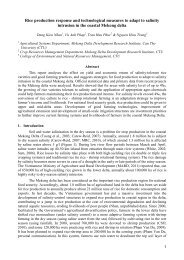start-with-the-park
You also want an ePaper? Increase the reach of your titles
YUMPU automatically turns print PDFs into web optimized ePapers that Google loves.
60 Start <strong>with</strong> <strong>the</strong> <strong>park</strong><br />
CASE STUDY<br />
Quaggy River Catchment,<br />
Lewisham, London<br />
The Quaggy is 14 kilometres long<br />
Construction period<br />
1998–2004<br />
Reduce flood risk imaginatively<br />
Background<br />
Urban development in <strong>the</strong> river valley and natural<br />
flood plain over <strong>the</strong> past 150 years has increased <strong>the</strong><br />
risk of flooding in <strong>the</strong> River Ravensbourne catchment.<br />
The traditional approach to flood alleviation had been<br />
to increase <strong>the</strong> capacity of <strong>the</strong> river channel by culverting<br />
and channel widening to allow water to flow quickly<br />
away from built-up areas. Unfortunately this cannot<br />
prevent catastrophic floods such as occurred in <strong>the</strong><br />
centre of Lewisham in 1968 – affecting hundreds<br />
of businesses and residents. A proposal to reduce<br />
flood risk and fur<strong>the</strong>r widen <strong>the</strong> channels along <strong>the</strong><br />
Quaggy caused <strong>the</strong> formation of a local community<br />
group – Quaggy Waterways Action Group – which<br />
successfully campaigned for an alternative approach to<br />
flood management that would allow <strong>the</strong> green spaces<br />
along <strong>the</strong> network to store water during peak flows and<br />
also facilitate a more natural and attractive meandering<br />
river. This approach was <strong>the</strong>n taken forward by <strong>the</strong><br />
Environment Agency.<br />
New development needs to avoid increasing flood<br />
risk. The new approach taken <strong>with</strong> <strong>the</strong> Quaggy is<br />
important as it integrates green space design <strong>with</strong><br />
water management. It reduces storm water run-off<br />
for Lewisham Town Centre as well as providing<br />
improved recreational <strong>park</strong>s for local communities<br />
and more variation in habitats that encourages<br />
greater biodiversity.<br />
Sutcliffe Park<br />
Until <strong>the</strong> work <strong>start</strong>ed in 2003, Sutcliffe Park was a<br />
flat, featureless area of grassland containing football<br />
pitches and an athletics track. The space was little<br />
used o<strong>the</strong>r than for weekend football. The river ran in<br />
a concrete culvert. The design concept at Sutcliffe<br />
Park was to create a multi-functional open space that<br />
would improve flood management and <strong>the</strong> quality of<br />
<strong>the</strong> <strong>park</strong>. A community liaison officer was appointed<br />
from <strong>the</strong> area to include local people and particularly<br />
local schools and youth groups. The space now forms<br />
a shallow valley centred on <strong>the</strong> meandering Quaggy<br />
River and a wide boardwalk that allows visitors to<br />
walk above <strong>the</strong> water. During periods of extremely<br />
high water flow, <strong>the</strong> flood alleviation scheme will<br />
automatically operate, allowing water to fill <strong>the</strong> <strong>park</strong><br />
slowly, taking 12 hours to reach a capacity of 35<br />
Olympic swimming pools. After <strong>the</strong> high flow has<br />
passed, <strong>the</strong> water can slowly flow back into <strong>the</strong> river.<br />
The system does not require any mechanical controls.<br />
Chinbrook Meadows<br />
Until 2002, Chinbrook Meadows was an under-used<br />
small <strong>park</strong> that was divided by a deep channel. High<br />
bushes and fences were put up to reduce <strong>the</strong> risk<br />
of visitors falling in and injuring <strong>the</strong>mselves.This was<br />
replaced by a meandering naturalised channel <strong>with</strong><br />
associated wetland, improving biodiversity <strong>with</strong>in <strong>the</strong><br />
<strong>park</strong> and reducing flood risk to adjacent properties.<br />
The <strong>park</strong> was redesigned and upgraded <strong>with</strong> new<br />
footpaths, tree and flower planting, gates, lighting,<br />
bridges, sports facilities, educational resources and<br />
art features.





